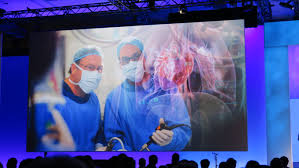Did you know that, in ancient times, doctors would routinely drill holes in the skulls of patients who were behaving abnormally in order to ward off evil spirits? Or that in the 19th Century, a series of “soothing syrups” containing morphine, heroine, codeine, and opium were formulated to aid stressed-out mothers with disobedient children? History is riddled with countless bizarre medical beliefs and practices, some of which actually caused more harm than good. Modern medicine, however, has evolved over thousands of years as each generation built upon the knowledge of earlier times and learned from past medical mistakes. Today, a new technological advancement is making headlines—one that has potential to completely revolutionize the way we practice medicine today.
 Earlier this year, Microsoft announced the introduction of their newest development—the Microsoft HoloLens. It is the first fully untethered, holographic computer, enabling high-definition holograms to integrate with the real world. In this day and age, everyone lives in a completely virtual world—texting and Skyping their friends rather than seeing them in person, shopping online instead of at the stores, even opting to explore the world through just a few clicks on Google Maps instead of travelling abroad to experience these different countries and cultures. Now imagine a world that is not confined to the virtual or digital spheres. This is exactly the idea behind Microsoft HoloLens. The developers at Microsoft recognize that humans live in the real world; thus, they created a device that could transfer anything people see virtually from their computer or phone screen into their real lives. The HoloLens mixes digital content into the user’s actual life to create a holographic landscape. This means that once the user puts the HoloLens on, anything they do online can come to life…right there in their own living room! Apps can come to life as users customize their own space to fit their likes and interests. Users can watch a video using a holographic screen that follows them wherever they go, play fetch with their holographic pet dog, and even design all sorts of things and see the finished product right there in front of their eyes! With Microsoft HoloLens, the possibilities are endless!
Earlier this year, Microsoft announced the introduction of their newest development—the Microsoft HoloLens. It is the first fully untethered, holographic computer, enabling high-definition holograms to integrate with the real world. In this day and age, everyone lives in a completely virtual world—texting and Skyping their friends rather than seeing them in person, shopping online instead of at the stores, even opting to explore the world through just a few clicks on Google Maps instead of travelling abroad to experience these different countries and cultures. Now imagine a world that is not confined to the virtual or digital spheres. This is exactly the idea behind Microsoft HoloLens. The developers at Microsoft recognize that humans live in the real world; thus, they created a device that could transfer anything people see virtually from their computer or phone screen into their real lives. The HoloLens mixes digital content into the user’s actual life to create a holographic landscape. This means that once the user puts the HoloLens on, anything they do online can come to life…right there in their own living room! Apps can come to life as users customize their own space to fit their likes and interests. Users can watch a video using a holographic screen that follows them wherever they go, play fetch with their holographic pet dog, and even design all sorts of things and see the finished product right there in front of their eyes! With Microsoft HoloLens, the possibilities are endless!
With its unique and incomparable capabilities, Microsoft HoloLens presents an exciting new way to teach and learn medicine. For example, with its ability to show 3D images of the human body, the HoloLens can show doctors and students animated, functioning versions of each of the bodily systems, something that cannot be achieved using a cadaver. Students can see how each of those systems are correlated, and they can even enlarge objects to see more detail and look inside objects to see what vessels travel through them. Furthermore, users can envision different types of bone fractures and the effects of various diseases on different parts of the body. By wearing the HoloLens as well, professors are able to see exactly what the students are seeing, and they can also receive pop-ups from students online or studying remotely. The Microsoft HoloLens allows students, doctors, and professors to visualize medicine in a whole new way and to be able to see how the different parts of the body work together and how they are affected by various things. 2016 is a brand new year—who knows what exciting advancements are in store for medical education!
Rachel Antol is an MS2 at The University of Arizona College of Medicine – Phoenix. She graduated from Arizona State University in 2014 with a degree in biology and a concentration in developmental biology. Growing up with a passion for reading and writing, Rachel has been involved in various writing opportunities throughout her life and is very excited to bring this joy to her medical school. For any questions or interest in submitting an article, please contact her at rachelantol[at]email.arizona.edu.

